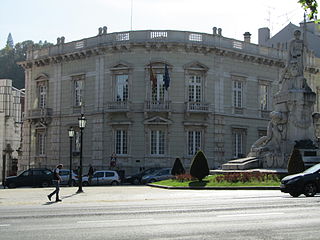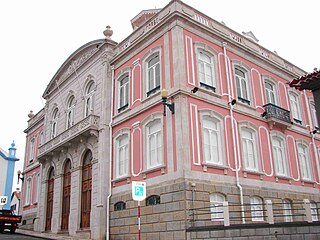
Caxias do Sul is a city in Rio Grande do Sul, Southern Brazil, situated in the state's mountainous Serra Gaúcha region. It was established by Italian immigrants on June 20, 1890. Today it is the second largest city in the state of Rio Grande do Sul. In 2020, the population of Caxias do Sul was estimated at 517,451 people, many of whom are of Italian and German descent. The demonym of the citizens of Caxias do Sul is Caxiense.
Talian, or Brazilian Venetian, is a dialect of the Venetian language, spoken primarily in the Serra Gaúcha region in the northeast of the state of Rio Grande do Sul in Brazil. It is also spoken in other parts of Rio Grande do Sul, as well as in parts of Espirito Santo and of Santa Catarina.

The Palace Bettencourt is a former residence of the Bettencourt family, and current seat of the public library and regional archive, in the civil parish, in the municipality of Angra do Heroísmo, in the Portuguese archipelago of the Azores.

The Angra do Heroísmo City Hall is a medieval structure constructed to house the municipal council/authority, situated in the civil parish of Sé, municipality of Angra do Heroísmo, on the Portuguese archipelago of the Azores.

The Tower of D. Pedro Pitões is a former-medieval fortification situated in the civil parish of Cedofeita, Santo Ildefonso, Sé, Miragaia, São Nicolau e Vitória, that protected the northern Portuguese city of Porto.

The Palacette of Belomonte is a former-residence on Rua de Belomonte, in the civil parish of Cedofeita, Santo Ildefonso, Sé, Miragaia, São Nicolau e Vitória, in the northern Portuguese city of Porto.

The Palacette of Viscounts of Balsemão is a former-residence in the civil parish of Cedofeita, Santo Ildefonso, Sé, Miragaia, São Nicolau e Vitória, in the northern Portuguese city of Porto.

The Palacete Mayer is a Portuguese eclectical residence situated in the civil parish of Santo António, municipality of Lisbon. In the 20th century, it was acquired by the Spanish government and became the Embassy of Spain in Portugal.

The Residence Silveira e Paulo is located on Rua da Conceição, in the civil parish of Nossa Senhora da Conceição, in the historic centre of Angra do Heroísmo, Terceira Island, in the Portuguese archipelago of the Azores. Completed in the style of the late 19th century, the residence is one of the more notable examples of Azorean civil construction in the transition between 19th and 20th centuries.
The Castle of Vila Nova de Foz Côa is a medieval castle located in the civil parish of Vila Nova de Foz Côa, in the municipality of Vila Nova de Foz Côa, Portuguese Guarda.

The Archbishop's Palace of Salvador is a Roman Catholic residence in Salvador, Bahia, Brazil. It is located on the Praça da Sé in the Pelourinho historical district of the city. The palace was built in the early eighteenth century and is one of the best examples of Portuguese colonial-period civil architecture in Brazil. The Archbishop's Palace was listed as a historic structure by the National Historic and Artistic Heritage Institute in 1938. IPHAN transferred ownership of the palace to the Roman Catholic Archdiocese of São Salvador da Bahia in 2011. The palace sits within the UNESCO World Heritage Site of the Historic Center of Salvador. Part of the structure was converted into a cultural center, the Cultural Center of the Palácio da Sé, which opened in 2020.
The Quinta de Santo António is a well-preserved Pombaline quinta in the freguesia of Carcavelos e Parede, in the municipality of Cascais, on the Portuguese Riviera. It is the seat of St. Julian's School.

The Mendoza mansion is a building located between Santa María Avenue and Arzobispo Malvar Street, at the western end of the old town of Pontevedra. It is currently the headquarters of the Rias Bajas Tourist Office.

The Dom Pedro II Home and later Portuguese: Asilo de Mendicidade Santa Isabel, is an 18th-century retirement home in Salvador, Bahia, Brazil. It was built as largest private residence in the 19th century in Bahia, and was renovated into a social services home in 1887. The current retirement home is administered by the Municipal Secretariat for Social Promotion and Fight against Poverty (SEMPS) of Salvador. The building, located at Avenida Luís Tarquínio nº 18, was listed as a historic structure by the National Institute of Historic and Artistic Heritage in 1978. The Dom Pedro II Home is likely the largest private residence built in Bahia, and is approximately 120 metres (390 ft) in length. Lindalva Justo de Oliveira, a Brazilian Vententian Sister, was murdered while working at the retirement home in 1993 and was subsequently beatified in 2007.

The governor of Rio Grande do Sul is the head of government of the state's executive branch, assisted by his secretaries, whom he freely chooses. Elected by absolute majority in universal suffrage, together with the vice-governor, his term lasts four years; since 1997, reelection has been possible, and although all have sought it, none has succeeded. The current governor is Eduardo Leite, since January 1, 2023.

The Bolonha Mansion is a historic residence in Belém, Pará, Brazil. It was built between 1905 and 1908 by the architect Francisco Bolonha (1872-1939) as a gift to his wife Alice Tem-Brink; he is also noted as the father of the modernist architect Francisco de Paula Lemos Bolonha. Bolonha was travelled extensively to Europe, and his works were greatly influence by Gustave Eiffel. The Bolonha Palace is a strong example of eclectic architecture in Brazil. It was listed as a historic structure by the Department of Historic, Artistic and Cultural Heritage of Pará in 1982.

The Historic Center of Caxias do Sul is a Special Sector of the city contemplated in its General Plan and regulated by specific legislation. It comprises the region that was first urbanized, located around the Dante Alighieri square and limited by the streets Os 18 do Forte, Bento Gonçalves, Alfredo Chaves, and Moreira César. The Historic Center has been the vital core of Caxias do Sul since its origin and has undergone profound changes since the early days, but it still preserves its original urban layout and a number of buildings of great architectural and historical interest. However, it has suffered from frequent traffic jams and the degradation of some stretches.

Abramo Eberle was an Italian–Brazilian businessman and one of the pioneers of industrialization in the state of Rio Grande do Sul.

Dante Alighieri Square is the oldest and most traditional public square in Caxias do Sul, Rio Grande do Sul, Brazil, located in the center of the city. It was included in the colony's floor plan from the beginning of the territory's occupation and was the stage for many important events, having in its surroundings several historical buildings of great importance.

The Nossa Senhora de Pompéia Hospital, also known as Pompéia Hospital, is a non-profit philanthropic hospital in Caxias do Sul, Brazil, specialized in many areas and with national coverage.


















